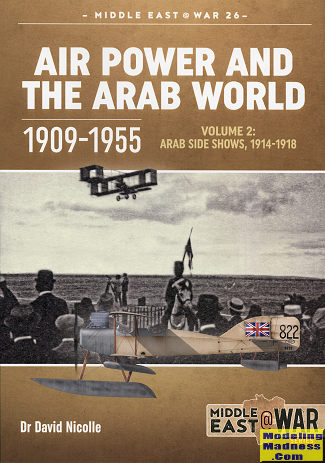 While much is
often made of the air forces of the Middle East and North Africa from the early
1960s on, there has been very little on what went on before that. Few realize
that there was aviation in this part of the world almost from the beginning of
flight. Prior to heavier than air craft, there were balloons used with some
success.
While much is
often made of the air forces of the Middle East and North Africa from the early
1960s on, there has been very little on what went on before that. Few realize
that there was aviation in this part of the world almost from the beginning of
flight. Prior to heavier than air craft, there were balloons used with some
success.
This volume covers air operations during and shortly
after WWI. In North Africa, the various land there was pretty much controlled by
four nations; Great Britain, Italy, France, and Spain. As such, this
edition covers air operations by these nation, mostly against the Ottoman
Empire, though the Germans did manage to get into the area somewhat to stir
things up. The local tribes were also very much of a problem to these European
nations as they did not like being under the control of others.
We open with the British with operations ranging from
Aden on the Arabian peninsula, through the area then known as the Levant (site
of modern day Israel, Jordan, Iraq, and Lebanon), into the border area between
Egypt and Libya. In this latter area, the main conflict was with the Sanussi. In
addition to dealing with the Ottomans, the British had to battle the Arab Revolt
of 1917 (think Lawrence of Arabia, though he was really a very minor part of
it).
Farther to the west was Italian Libya. Libya's borders
were quite fluid and not firmly established. Italians had to deal with the
Sanussi in the east and Berber tribes in the west. This bordered with the French
in Tunisia, Algeria, and French Morrocco with the French also having to be
concerned with Berber tribes. Meanwhile even farther west were the Spanish in
Spanish Morrocco. Spain takes up very little in the book as they utilized very
little air power during this time.
The Italians were not heavy air power users either, though they
did use balloons/blimps to help with reconnaissance. Aside from the
large British use of air craft, including seaplanes, the French were able to
successfully utilize aircraft and air ships for not only reconnaissance, but to
take the attack on to rebelling forces deep in the deserts where they thought
themselves immune. A situation that all nations faced was that the main war was
in Europe and there was little available for secondary fronts. Indeed, most
aircraft sent to these areas were those that were no longer front line types
that had been removed from service as newer aircraft became available. This
meant that often aircraft were war weary and prone to breakdowns. Nevertheless,
they were better than no aircraft and thanks to the hard work of ground crews,
were able to be a telling force.
The author has provided an excellent book on a
very little known and little researched subject. I was fairly
surprised at how many images there were, as that really helps in books like
this. The level of detail regarding the operations and units of the time is
quite remarkable and you are provided an interesting look into how these units
functioned. Add in some very nice color profiles and excellent maps and you have
a fascinating book on early aviation. Highly recommended, especially if you are
tired of the usual WWII stuff that seems to be everywhere.
January 2021
Copyright ModelingMadness.com. All rights reserved.
Review book courtesy of
Casemate Publishing, where you can order your copy
at this
link.
If you would like your product reviewed fairly and
fairly quickly, please
contact
the editor or see other details in the
Note to
Contributors.
 While much is
often made of the air forces of the Middle East and North Africa from the early
1960s on, there has been very little on what went on before that. Few realize
that there was aviation in this part of the world almost from the beginning of
flight. Prior to heavier than air craft, there were balloons used with some
success.
While much is
often made of the air forces of the Middle East and North Africa from the early
1960s on, there has been very little on what went on before that. Few realize
that there was aviation in this part of the world almost from the beginning of
flight. Prior to heavier than air craft, there were balloons used with some
success.